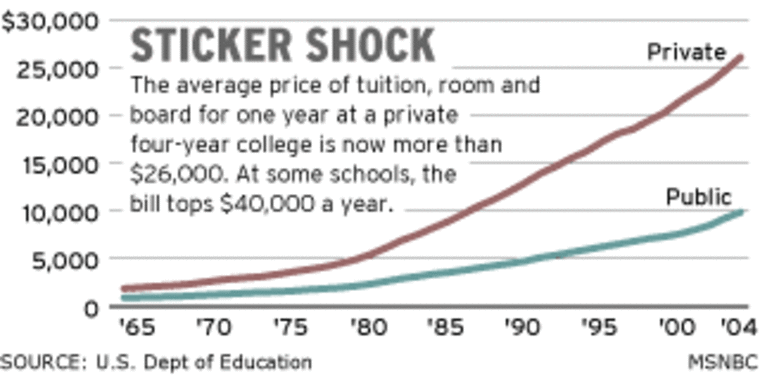With the cost of a year of college now topping $40,000 a year at many private four-year schools, the impact on family budgets has never been greater. And neither has the desire of families to find sources of financial aid to help cover that cost.
As a result, more families are trying to manage their personal finances to maximize their chances of getting aid — in some cases by shifting assets so they are not counted in financial aid formulas.
“Parents are very interested in this,” said Mark Kantrowitz, publisher of FinAid.org, a Web site devoted to financial aid. Each week some 50,000 visitors check out the site’s section on maximizing aid eligibility, he said.
But sorting out the best moves is not easy: In general, there are no hard and fast rules. And while there is nothing wrong with rearranging your finances to increase the chances of getting aid, parents who try too hard to game the system risk being charged with a crime.
“I have seen people lie about assets that they have,” said Ray Loewe, founder of College Money, a New Jersey advisory firm that specializes in college finances. “Basically, if you have an asset and you don’t disclose it, it’s fraud.”
The pot of money that parents of college-bound students are chasing is huge. Last year, more than $69 billion in federal grants, loans and work-study jobs was awarded to more than 10 million students and families, according to the Department of Education. Billions more were awarded by individual colleges and universities from their own endowments.

To determine eligibility for federal aid, the Free Application For Federal Student Aid, or FAFSA, formula takes into account parent and student income and assets to determine the "expected family contribution" — or how much of the financial burden the family is expected to shoulder. The formula also takes into account how many students are in college — the more siblings enrolled, the greater the chances the family will qualify. And it looks at the age of the oldest parent, giving more consideration to families with a wage-earner closer to retirement.
Shifting assets
The federal formula doesn’t count certain assets — like retirement accounts, annuities or the home equity in a family's primary residence. So one way to increase aid eligibility is to use cash or other investments, which are counted by the formula, to pay down a home mortgage or pay off credit card debt.
“It also makes good sense from a financial planning perspective,” said Kantrowitz, “since your bank account is probably earning only 1 percent, while the mortgage is costing you 6 or 7 percent or more and your credit cards as much as 18 percent.”
Some families may be able to increase their eligibility by using a Roth IRA as a combined retirement/college savings account. In some cases, Roth IRA contributions can be used to pay college expenses without incurring taxes or penalties.
And many families are better off shifting college savings that may have been accumulated in the child’s name back to the parents. While there may be tax advantages to keeping investments in a child’s lower income bracket, the financial aid formula leans much more heavily on assets held by the student than those in the parent’s name.
Adding to the complexity is the fact that a financial move that helps one family get more aid may hurt another family’s chances.
While the FAFSA formula is used to dole out federal grants, for example, schools use a separate, so-called “institutional” formula to decide how to spend their own money on financial aid. These formulas count some assets, like a family’s primary residence, that the federal formula doesn’t.
Though these “institutional” formulas tend to be more restrictive, they also give colleges wider latitude in considering special circumstances — like an unexpected medical expense or a recent job loss — when deciding how much aid to offer.
Besides the complexities in sorting out aid formulas, there are other potential pitfalls in trying to maximize financial aid.
For starters, some families fall victim to bogus advisers who promise more than they can deliver. These scholarship scams take in more than $100 million a year from hundreds of thousands of victims, says Kantrowitz of FinAid.org. Many turn to the Federal Trade Commission, which gets hundreds of fraud complaints about these scam artists who collect upfront, promising to line up scholarships and financial aid, and then provide little or nothing in return.
“They’ll charge you a fee to pull down the same information you can find yourself with a half hour’s worth of time on the Internet,” Jackie Dizdul, an FTC spokeswoman.
And, in their zeal to try to demonstrate a need for financial aid, some families cross the line themselves by trying to hide assets or simply not disclosing them. Not only do these families risk getting caught in a lie, they risk being charged with a federal offense.
“There is a statement on the form that it’s a federal form, just like your income tax reports, and that lying and intentionally misrepresenting information is a crime,” said Stephanie Babyak, a spokeswoman for the Department of Education.
That kind of fraud is getting easier to detect. The Department of Education requires that 30 percent of all aid applications be verified, which means they have to be backed up with tax returns, bank statements, brokerage accounts, etc.
Cases of suspected fraud are referred to the Office of Inspector General, which recently found that 4 percent of federal Pell grant recipients supplied information on the FAFSA form that was different from what they reported to the Internal Revenue Service, according to Kantrowitz.
Most colleges verify applications on their own. That means “ballpark” estimates of assets like how much your house is worth will have to hold up to fairly rigorous scrutiny.
“If it’s in shooting distance, OK,” said Joe Paul Case, director of financial aid at Amherst College. “But if it’s a home that zillow.com will tell you is worth $1 million, and they’re saying, ‘Oh no, it’s worth $400,000,’ you might make an adjustment.”
In most cases, if a college suspects an applicant is trying to game the system, the family is offered the chance to revise the application with more complete information, said Case.
“If you’ve given them the opportunity, and you’re still convinced this family is misrepresenting the facts, you can pass it on to the Department of Education,” he said. “Whether the department does anything with it is another question.”
Moves that can backfire
In the end, the complex formulas used to determine aid eligibility, along with comprehensive reviews by college financial aid offices, don’t leave a lot of room for financial maneuvering.
The impact of many of these these moves can be limited. A big change in reported assets, for example, may produce only a relatively small increase in aid. And rewriting your lifetime financial plan to maximize aid for a few years of college tuition can backfire in the long run, say advisors.
“If I take $10,000 and reduce my mortgage I’m only going to get $500 to $600 more in financial aid,” said Loewe. “What I’m giving up is liquid cash that might come in handy while I’ve got kids in college.”
There’s also plenty of financial aid available that doesn’t require families to demonstrate need. In additional to scholarship money from private groups, individual colleges and universities routinely award financial aid to students they want to recruit, based on the students’ academic or athletic skills and accomplishments.
Though students often can’t apply for these awards, they can keep an eye out for schools that may be especially interested in their particular strengths, said Loewe.
“There are a lot of colleges that are in the midpriced range, usually the smaller private schools, that have been moving financial aid dollars into their marketing budgets,” he said. “So if you have a student in the top quarter of the incoming class, there are a lot of presidential scholarships and university scholarships that are given to discount the tuition bill because they want you as a student.”
In many cases, colleges don’t advertise these awards. But students can maximize their chances for winning them by applying to colleges where their grades and College Board scores compare favorably with the average incoming student, said Loewe.
